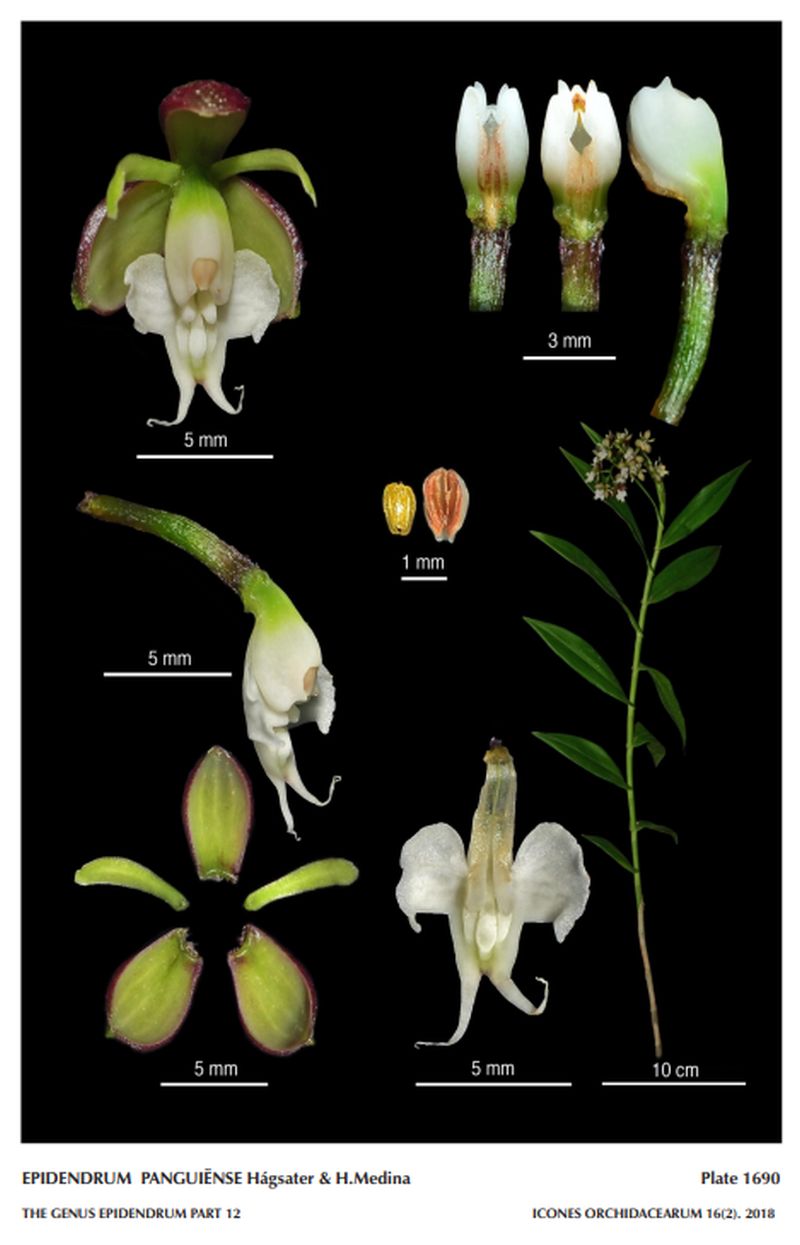

Epidendrum panguiense Hágsater & H.Medina 2018 GROUP Bicirrhatum
TYPE LCDP /TYPE Photo © by H Medina and The AMO Herbario Website

 LATER
LATER
Common Name The El Pangui Epidendrum [Town near the discovery site of the orchid]
Flower Size .4" [1 cm]
Found in Zamora-Chinchipe province of Ecuador near rivers at the foot of the Cordillera del Cóndor, at elevations around 800 meters as a cane-like, simple, erect, terete, thin, the basal portion covered by several non-foliar, becoming grayish, imbricate, tubular, acute sheaths, carrying up to 19 per stem, distributed throughout the apical half of the stem, sub-erect, fleshy, appearing as wax covered; leaf sheaths tubular, pale green; blade lanceolate, acuminate, 7 veins apparent on the underside, smooth above, margin entire, spreading leaves that blooms in the later spring on a terminal, without a spathe, peduncle .96 x .72" [24 x 1.8 mm], thin, somewhat laterally compressed, short, covered by 2 linear-lanceolate, acuminate, embracing bracts; racemes 3, with 8 to 11 flowers each, subtended by a prominent embracing bract, paniculate, arching, densely simultaneously to ca. 30 flowered inflorescence with progressively longer, shorter than the ovary, linear-triangular, acuminate, embracing floral bracts and carrying. resupinate flowers, with the sepals dorsally dark reddish brown, green inside, petals green, column and lip white, anther pale ochre; without fragrance.
"Epidendrum panguiënse belongs to the GROUP Bicirrhatum , a small group of species which has appeared recently and is characterized by the caespitose habit, simple, leafy, short stems, compact, nodding inflorescence, conspicuous bracts about as long as the ovary, numerous fleshy, green and/or white flowers, with the mid-lobe deeply bilobulate, the lobules sometimes cirrate; the pollinia are thin and unequal, the inner pair smaller, without being of the bird-wing-type. The new species is recognized by the dark reddish-brown, pustulate dorsal surface of the sepals, flowers green inside with a pure white column and lip, lateral lobes of the lip semi-orbicular, mid-lobe deeply bifid, forming a pair of linear-triangular, long acuminate, cirrate, somewhat divergent and involute lobes. Epidendrum enantilobum Hágsater has green to cream colored flowers, lip and column white, sepals .16 to 2" [4 to 5 mm] long, dorsally smooth, lateral lobes falcate-oblong, mid-lobe formed by two opposite, narrow, ciliate, short lobes. Epidendrum xelidonourum Hágsater & H.Medina has sepals .256 to .28" [6.4 to 7.0 mm] long, very pale greenish white flowers, base of sepals, petals and column green, column and lip white, lateral lobes of the lip ¼ circle, mid-lobe basal half sub-rectangular, slightly slimmer at the middle, apical half bilobed, lobes linear triangular, acuminate, arching-divaricate, reminiscent of the tail of barn swallows. Epidendrum brachyblastum Hágsater & Dodson has narrower, hemi-ovate lateral lobes of lip, and deep green flowers with lip and apical half of column snow white. Epidendrum hugomedinae Hágsater has snow-white flowers with keels of lip tinged violet and obcuneate mid-lobe formed by two, rounded, somewhat divergent, lobes. Epidendrum tiwinzaënse Hágsater & Dodson has green flowers with a white lip and apical half of column, and sepals some .28" [7 mm] long, lip terminating in a pair of cirrate lobes. Epidendrum bicirrhatum D.E. Benn. & Christenson from northern Peru has pale cream-orange flowers with base of the sepals and petals green, tips of keels of the lip lavender, flowers are smaller, sepals being .184 to 2.8" [4.6 to 5.2 mm] long, and lip has denticulate margins on sub-orbicular lateral lobes, and cirrate lobules on mid-lobe. The Bolivian E. ophidion Dodson & R.Vásquez is quite similar to latter, but has successive, yellow flowers with three purple lines on the disc, pustulate sepals .24 to .32 [6 to 8 mm] long, and dolabriform lateral lobes with a crenulate margin, mid-lobe formed by two strongly curved, short cirrate lobes." Hagsater etal 2018
Synonyms
References W3 Tropicos, Kew Monocot list , IPNI ; *Icones Orchidacearum 16[2] Plate 1690 Hagsater & Sanchez 2018 LCDP/photo fide;
----------------------------------------------------------------------------------------------------------